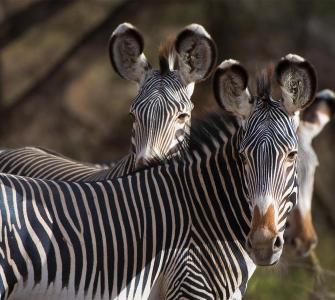Our partner, Grevy’s Zebra Trust (GZT), is an independent wildlife conservation Trust protecting Grevy’s zebra (Equus grevyi) in the community rangelands of Kenya. They are the only organisation that is 100% dedicated towards saving the endangered Grevy’s zebra, of which only 3,000 are left in the wild.
Conservation Strategy Fund (CSF) supported GZT by building a compelling case for investing in rangeland restoration activities, equivalent to a restoration offset, in Samburu, Isiolo and Marsabit Counties in northern Kenya. The potential investment will be aimed at producing a biodiversity net gain, supporting the growth of the endangered Grevy’s zebra population and enhancing the associated ecosystem services. This information will inform potential Kenyan biodiversity, habitat or restoration offset policy, justifying why offsets can be a valuable form of conservation finance in areas of high infrastructural development.
Key Results
CSF economists conducted an ecosystem service valuation comparing degraded and restored grassland scenarios to assess how restoration enhances ecosystem benefits and economic resilience. The study valued 371,431 hectares of grasslands—representing 29% of the study area—and estimated the annual economic value of ecosystem services at $1,359 per hectare for degraded (annual-dominated) grasslands and $1,599 per hectare for restored (perennial-dominated) systems.
Under drought conditions, degraded grasslands lost around 60% of their total economic value, dropping from $523 million to $216 million, while restored perennial systems lost only 16%, from $567 million to $420 million. This difference—worth approximately $203 million annually—shows how restoration significantly increases drought resilience and long-term economic stability.
The study also compared the costs and returns of two restoration approaches:
- Earth bunds (semi-circular soil structures): Costing about $752 per hectare with an ROI of 112.7%, returning $1.13 in net benefits for every dollar invested.
- Holistic Land and Livestock Management (HLLM): Costing only $7 per hectare but delivering equivalent ecosystem benefits, resulting in an exceptional ROI of 21,484%—over $215 in net benefits per dollar invested.
These findings make a clear economic case for scaling up grassland restoration as a cost-effective strategy for biodiversity, climate adaptation, and community resilience. Beyond the immediate ecological gains, restoration offsets and Payment for Ecosystem Services (PES) schemes could channel finance from infrastructure projects—such as the LAPSSET Corridor—into rangeland conservation.
By quantifying the tangible benefits of healthy grasslands, this work supports the development of Kenyan biodiversity, habitat, and restoration offset policies, demonstrating that investing in ecosystem restoration is not just good for wildlife—it’s smart economics for people and nature.
____
Photo: Grevy's Zebra, from the African Wildlife Foundation's website

